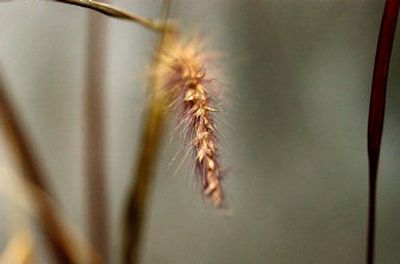Gardening with grass

Ornamental grasses are one hot garden plant right now, and when you look around Spokane, more and more plantings of grasses are appearing every year.
For members of the Spokane-based Independent Landscape Design Association, ornamental grasses are a cornerstone of many of their designs. Grasses are one of the most versatile plants in the garden and fit in almost any setting with stunning results.
“They add year-round texture in a way that few annual, perennials or shrubs can,” said Brenda Bumann of Heartland Home and Garden Solutions.
As design elements
There is an ornamental grass for every season, setting and use in the garden. Grasses come in sizes from being small enough to be groundcovers in a tight space, up to those that can get 10 feet or more in height and make great hedges. They can be used in wet places, dry places, and some in standing water, and other varieties thrive in shade.
“Grasses add vertical accents to perennial borders and pots and can create a backdrop or soft hedge for perennial borders in large-scale landscapes,” says landscape architect Barbara Safranek. “They give a landscape a softer, more casual ambiance.” Safranek also uses grasses to bridge the space between sunny and shady areas of the garden.
Jean Taylor of GreenJeans Garden Design is currently working with a client who wants a lush, almost tropical look in a small perennial border.
“She loves pampas grass, but as it isn’t hardy here, I’m placing one large hardy pampas grass (Erianthus ravennae) as a huge focal point where it will also serve as a kind of wind shield for the rest of the plantings,” says Taylor.
Many garden designers use grasses as a way to blur the boundary between the managed garden and any surrounding natural woods or fields.
Smaller grasses are great in the small garden or in pots.
“I use grass in potscapes,” says Lori Kinnear of Kinnear Landscape Design. “Their texture, height and color are perfect with annuals and perennials in containers. Their cultural needs must be matched with appropriate annuals or perennials and pot size, and color is always a consideration.”
Grasses as wind and light catchers
Grasses are unique in their ability to catch wind and light in the garden. Their long narrow leaves and seed heads move easily in the slightest breeze, creating motion in a bed.
Grasses glow in the morning or late-day sunlight. Their translucent blades catch light in a way that makes them and any plantings around them glow with a warm, soft color. This coloring intensifies in the fall and winter, when the grasses turn tan, gold, bronze and red.
For Debbie Goodwin, a horticultural instructor at Spokane Community College, grasses add sound to a garden. “As the grasses move in the wind, they rustle softly,” she says.
Grasses are low-maintenance
Grasses are nearly maintenance free. With a few exceptions, most need no more than a haircut in the early spring to remove old foliage followed by a top dressing of compost.
“The Calamagrostis (feather reed grasses) only looks bad for about two weeks after I cut it back in March,” says Brenda Bumann
Grasses aren’t bothered by bugs or disease. The clump-forming grasses stay a manageable size and don’t have to be hacked back like shrubs that grow too big. Some are quite shade tolerant. And many grasses mature quickly, often reaching their full size in two to three years.
Some grasses are very deer resistant. “I have placed ornamental grasses in areas that the deer eat everything, but they leave the grasses alone,” says Bumann.
A few negatives
Grasses do come with a few downsides. Belinda Driscol of Firwood Nursery in Deer Park finds that some of them are not as hardy in the colder parts of the Inland Northwest. And in a rural garden, grasses can be a magnet for voles and mice, who like to hide under their foliage in the winter.
“I went to clean out the Karl Forester (feather reed grass), and it had no roots,” she says. In the snowy parts of the Inland Northwest, grasses are usually brought down by the first good heavy snow.